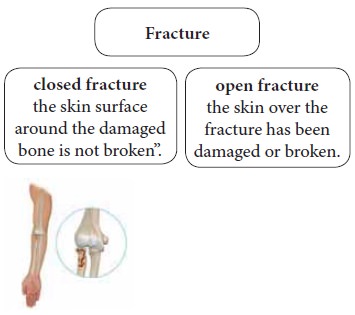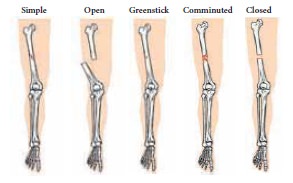Causes, Types | First Aid - Fracture | 11th Nursing : Chapter 9 : First Aid
Chapter: 11th Nursing : Chapter 9 : First Aid
Fracture
Fracture
A break or crack in a
bone is called a fracture.
A dislocation is where
a bone has been displaced from its normal position at a joint. A fracture is
when a bone has been broken.

Causes;-
Direct force:- A bone may break at the point where a heavy blow is received.
Indirect force:- a bone breaks away from the spot of application of force.
Types of Fracture
Simple fracture
This is the clean break or crack in the bone
Compound fracture
in this type of fracture the skin is torn by the broken bone which may protrude through the wound
Greenstick fracture
Is a break that happens on oneside of a bone.
Comminuted fracture
This type of fracture produce multiple fragments
Impacted fracture
This type of fracture the ends of the broken bone driven in to each other.

What to look for – fractures
Swelling.
Pain at or near the
site of injury.
Difficulty moving.
Movement in an
unnatural direction.
A limb that looks
shorter, twisted or bent.
A grating noise or
feeling.
Loss of strength .
The aims of first aid for the fractures are:
1.
To prevent further damage
2.
To reduce pain and shock
3.
To make the patient feel comfortable
4.
To get medical aid as soon as possible.
If you suspect that someone has fractured a bone
Do’s
·
Stop any bleeding .
·
Immobilize the injured part.
·
Apply ice pack wraped in a towel .
·
Treat for shock.
Don’ts
·
Do not force anyone to use a painful body part.
·
Do not straighten a misshapen bone.
·
Do not place ice/cold pack directly on skin.
·
Do not move victim if neck or spine injury is suspected, unless
absolutely necessary.
·
Do not move until injury has been immobilized.
·
Do not remove shoes, boots, or clothes around a possible
fracture.
·
Splinting is unnecessary if victim can give the broken bone
sufficient support and immobility.
·
Do not splint a possible fractured bone if doing so causes pain.
· Do not Massage the affected area
Dislocation of Joints
A joint is where two
bones join or connect. A dislocated joint happens when bones are partly or
completely pulled out of their normal position.
The most common joints
that dislocate are the shoulder, knee, jaw, or joints in the thumbs or fingers.
Signs of Dislocated joints
The four signs of a
dislocated joint are:
1.
Strong, sickening pain
2.
Not being able to move the joint
3.
Swelling and bruising around the joint
4.
Shortening, bending or deformity of the joint
First aid for dislocated joints
·
Advise them to stay still and help them to support their
dislocated joint in the most comfortable position.
·
Stop the joint from moving using a bandage. For an arm injury,
make a sling to support the arm. For a leg injury, use padding or broad-fold
bandages..
·
Apply an ice pack. Ice can ease swelling and pain in and around
the joint.
·
Once you’ve stopped the joint from moving, take or send the
injured person to hospital.
·
Keep checking their breathing, pulse and level of response.
Check the circulation beyond the bandages every ten minutes and loosen if
necessary.
Related Topics